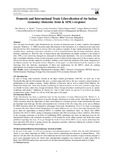Domestic and international trade liberalisation of the indian economy: domestic firms & MNCs response
Citation
Tonmoy, M. A., Choudhury, T., Rahman, T., Ashique, K., & Adnan, M. (2014). Domestic and International Trade Liberalisation of the Indian Economy : Domestic firms & MNCs response. International Affairs and Global Strategy, 20, 1–5.Abstract
Over the past two decades trade liberalisation has become an important part of many countries development
strategies. Winters L. A. (2004) describes trade liberalisation is the elimination of or reduction in the trade rules
that prevent free flow of products or services from one country to another. It may contain dismantling of fare for
example duties, surcharges, and export subsidies as well as nontariff barriers like licensing regulations, quotas,
arbitrary standards etc. With the start of improvements and liberalisation the Indian economy in the month of
July, 1991, a new period has emerged for India and its billion plus inhabitants. This era of economic shift has
had a remarkable influence on the overall economic growth of almost all the major areas of the economy, and its
effects over the last decade cannot be overlooked. Further, it also results the initiation of the actual integration of
the Indian economy into the global context. Objective of this paper is to find what has been the response to this
challenge from the domestic corporations of India and implications for the MNCs which are seeking
opportunities for locating or relocating their subsidiaries over there.

